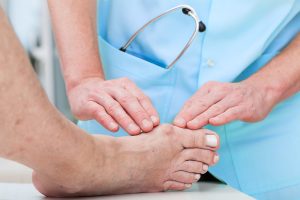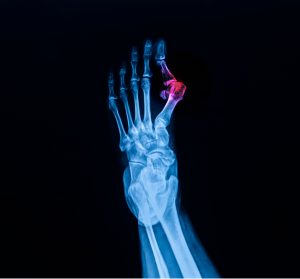At the Center of Spine and Orthopedics, our goal is to help you achieve the highest level of function as quickly as possible, so that you can, once again, enjoy your favorite activities. Bunions are a condition when a misalignment of bones in the foot can make the simple activity of walking, extremely painful. Dr. Eric Kuhlman, DPM, AACFAS is the Podiatrist & Foot and Ankle Surgeon at CSO, who specializes in foot and ankle reconstructive surgery, arthroscopy and trauma, sports medicine, diabetic wound care and diabetic Charcot reconstruction. The article below has more information on bunions and their treatment. If you are experiencing pain from bunions, please call us and schedule an appointment with our fellowship trained podiatrist.
Bunions and bunionettes
Bunions are among the most common causes of painful toes. A bunion is a misalignment of the bones in the foot. This occurs when something causes the big toe to turn inward, bending toward (or even under) the other toes. The medical term for bunion—hallux valgus deformity—is a literal description of the condition. “Hallux” is Latin for big toe, “valgus” is Latin for misalignment.

A bunionette is a similar condition that affects the base of the baby toe. It is sometimes called a “tailor’s bunion,” because tailors once sat cross-legged all day, with the outer sides of their feet rubbing on the ground.
Bunions plague more than half of all American women, and a quarter of men. They are twice as common among people over age 60, compared with younger adults.
Bunions and bunionettes can result from heredity, arthritis, or misalignment of the foot. But the most frequent cause is wearing shoes that squeeze the toes into pointy or narrow toe boxes, forcing the toes to fold over one another to fit in.
Neither condition may cause any pain at first, but you might notice that you have developed a bump on the side of your foot, or that it’s harder to put on tight shoes. In time, a bunion or bunionette can become extremely painful.
Symptoms of bunions and bunionettes
Common symptoms of bunions and bunionettes include:
- a bony protuberance at base of big toe (for bunion) or fifth toe (for bunionette)
- pain, especially when wearing shoes that press against the bump
Preventing bunions and bunionettes
Wearing shoes that provide sufficient room in the toe boxes is the best strategy for preventing bunions and bunionettes from developing. Look for shoes with blunt toes rather than pointy ones, and allow for about a quarter-inch to a half-inch of space between your longest toe and the front of the shoe.
Treating bunions and bunionettes
Well-fitting shoes, as described above, can help prevent a bunion or bunionettes from getting worse.
You can ease the pain of a bunion or bunionette by padding it with felt, moleskin, or a donut-shaped pad before slipping your feet into your stockings.
Another helpful aid is a shoe stretcher. This has a plastic plug that can be placed in the shoe to stretch the bunion/bunionette area, which relieves pressure on the foot at that point. A shoe inserts (orthosis) can redistribute your weight so the bunion doesn’t constantly rub against your shoe.
Mild and moderate bunions and bunionettes may not hurt, but severe ones — in which the protuberance is large and the toe slants noticeably toward the others — usually do.
To deal with pain, especially when the bunion or bunionette is inflamed, try a nonsteroidal anti-inflammatory drug such as aspirin, ibuprofen (Advil, Motrin, others), or naproxen (Aleve, Naprosyn, others). Hot and cold compresses may also bring some relief.
Surgery
If these steps don’t work, and you are still experiencing significant pain that interferes with daily activities, you may need to consider surgery to restore the toe to its normal position. Surgery is a major step that does not always eliminate all symptoms and will require you to stay off your foot for six to 12 weeks.
 If your doctor recommends surgery, the specific procedure will depend on the severity of your condition. Several procedures are available.
If your doctor recommends surgery, the specific procedure will depend on the severity of your condition. Several procedures are available.
- Mild bunions.
The modified McBride procedure shaves the enlarged portion of the bone and realigns the muscles, tendons, and ligaments. Recovery from this type of surgery typically takes at least six weeks. - Moderate bunions.
The chevron procedure cuts the bone close to the metatarsal head and then shifts it back into its proper position. Recovery takes about six to 12 weeks, during which you may be advised not to walk on your foot. - Severe bunions.
A cut is made further down the metatarsal bone. The surgeon may keep the bones in position with pins, screws, or plates. Recovery from this procedure, known as a proximal osteotomy, takes at least three months.
The decision to have surgery should be made carefully. Some people still experience symptoms after undergoing surgery, which makes sense considering that the procedure moves muscles, ligaments, and bones that have been accustomed to being in the same place for years. Moving them to a new position can, in itself, cause pain in some people.
During recovery from bunion surgery, you may have to wear a bandage and special shoe, or possibly a cast. The special shoe or cast will protect your foot, allowing it to heal, while letting you walk on your heel. During recovery, your muscles and other soft tissues will wither away a bit, so after the shoe or cast is removed you may have to do exercises to regain your strength and flexibility. It may take as long as six months to recover fully (to the point where you can do strenuous activities).
Similar surgical procedures can be performed for bunionettes, and the recovery time is usually somewhat shorter.
Original article published on HarvardHealth.







